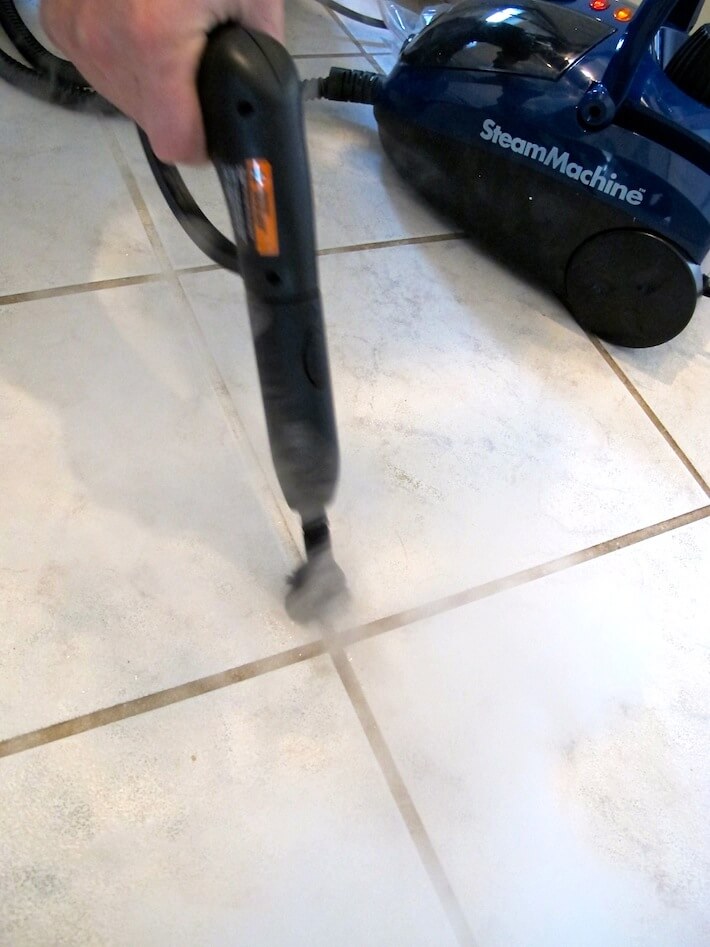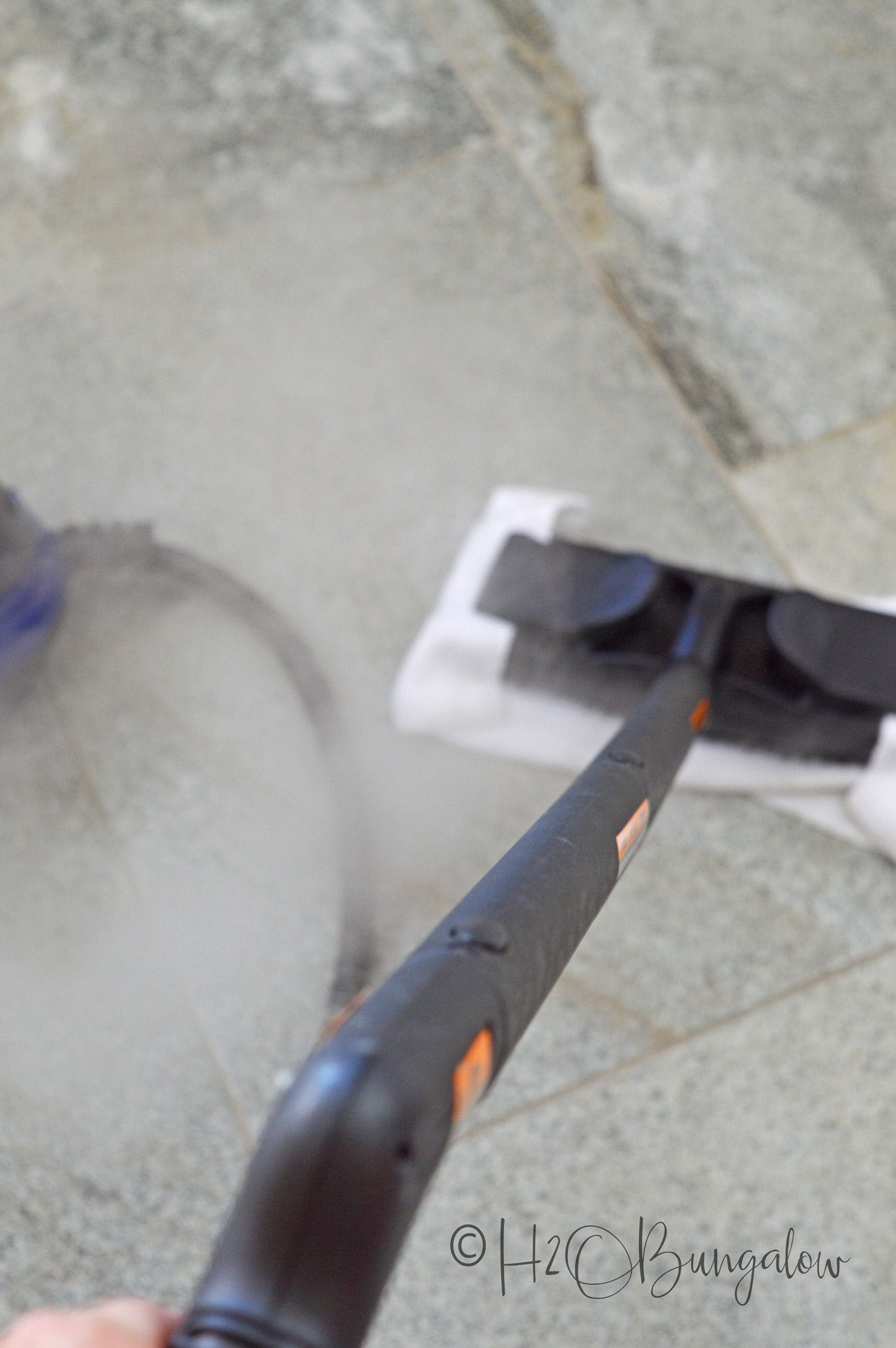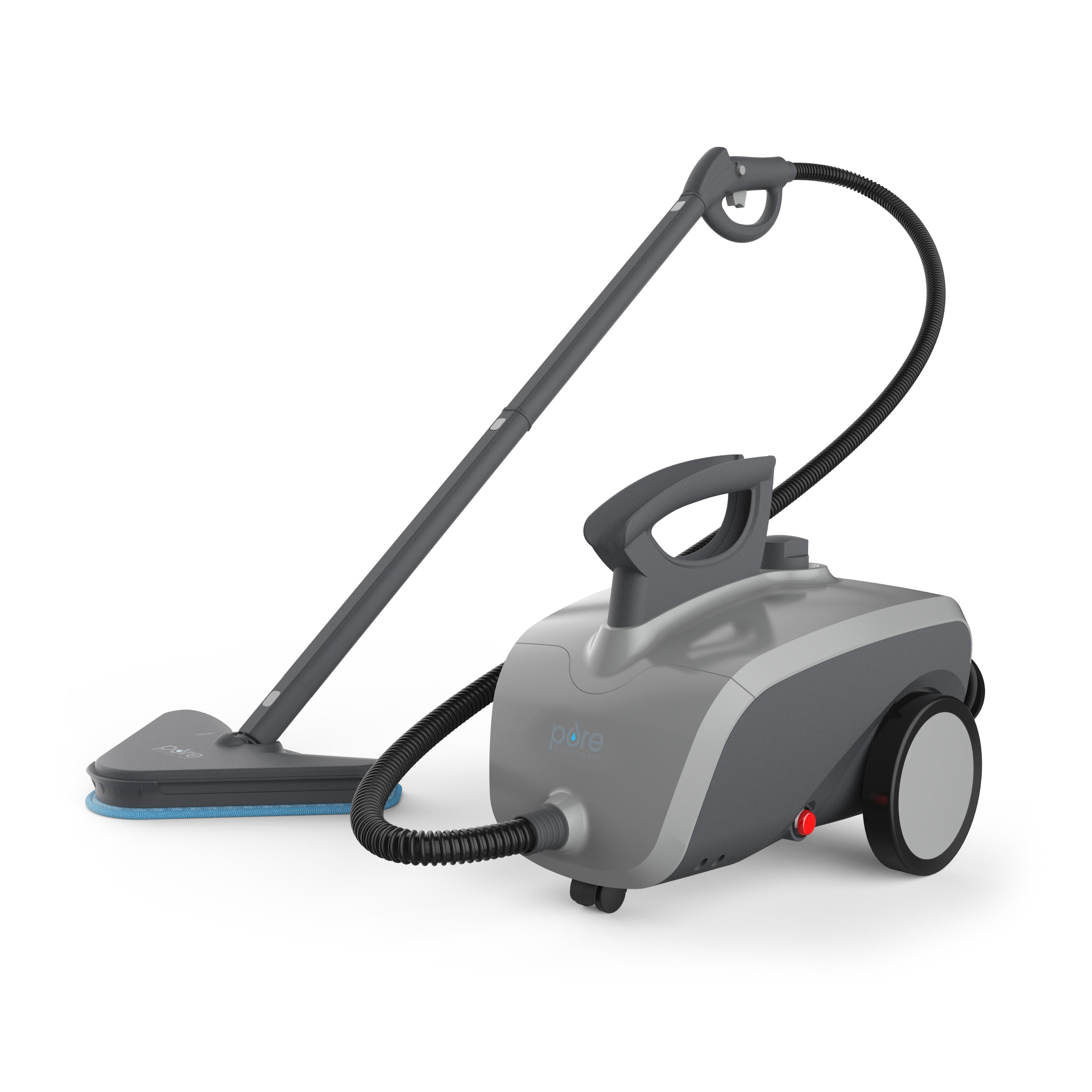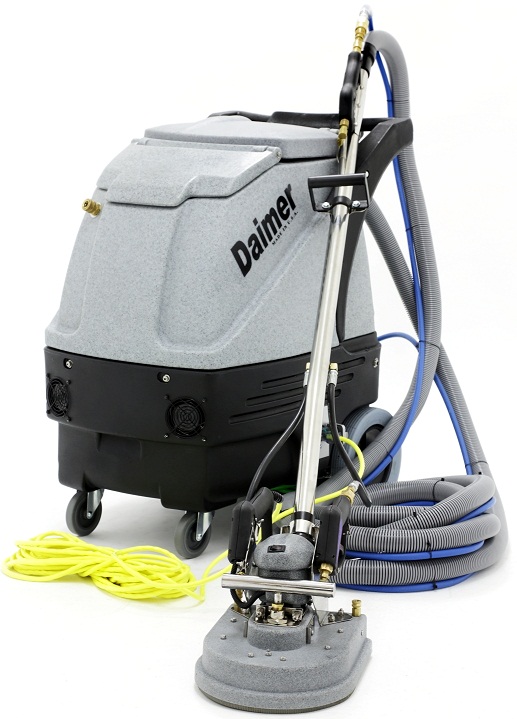Understanding the Basics of Steam Cleaning Tile Floors
Steam cleaning tile floors is efficient and eco-friendly to keep your home spotless. Instead of relying on harsh chemicals, steam cleaning uses the power of hot water vapor to sanitize and clean surfaces. The concept is straightforward: water is heated to a high temperature until it turns into steam, which is then applied to the tile surface through a cleaning machine. The steam’s high temperature helps break down dirt, grime, and stains, making them easier to remove. This process cleans and sanitizes the floors, killing most bacteria and germs on contact.
The benefits of steam cleaning go beyond just surface-level cleaning. Because steam penetrates the pores of the tile and grout, it can reach areas that traditional mopping or scrubbing methods might miss. This deep cleaning action helps to remove embedded dirt and stains, restoring the natural color and luster of your tile floors. It’s particularly effective in high-traffic areas where dirt tends to accumulate more rapidly.
Another advantage of steam cleaning is that it’s environmentally friendly. Unlike chemical cleaners, steam cleaning only requires water and heat, making it a non-toxic option for households, especially those with children or pets. The absence of chemical residues also means your floors are safer and less likely to cause allergic reactions. Additionally, steam cleaning reduces the need for disposable cleaning products, making it a sustainable choice.
However, it’s essential to understand the limitations and precautions of steam cleaning. While it’s suitable for most types of tile floors, certain surfaces may not respond well to high heat and moisture. For example, unsealed tiles, natural stone, or porous materials could be damaged by steam. Always check the manufacturer’s guidelines for your specific flooring type before using a steam cleaner.
The effectiveness of steam cleaning also depends on the type of steam cleaner you use. There are various models available, ranging from handheld devices for small areas to larger units for entire floors. Some steam cleaners come with additional attachments, such as brushes or squeegees, to enhance their versatility. Investing in a high-quality steam cleaner with adjustable steam settings will allow you to tailor the cleaning process to different surfaces and stains.
In terms of frequency, steam cleaning tile floors can be done as often as needed, depending on the level of foot traffic and the presence of dirt or spills. For regular maintenance, a once-a-week steam clean might suffice, but in homes with pets or small children, more frequent cleaning may be necessary to maintain a hygienic environment.

Preparing Your Tile Floors for Steam Cleaning
Proper preparation is key to achieving the best results when steam cleaning tile floors. The first step is to clear the area of any furniture, rugs, or obstacles that might get in the way during the cleaning process. This not only gives you a clear working space but also prevents potential damage to your belongings from the steam or moisture.
Next, it’s important to sweep or vacuum the tile floor thoroughly to remove loose dirt, dust, and debris. This step is crucial because steam cleaning is most effective when applied to surfaces that are free from large particles. If these particles are left on the floor, they can get pushed around by the steam cleaner, potentially scratching the tiles or creating streaks.
Once the floor is free of loose dirt, you should inspect the grout lines and tiles for any stains or spots that might need pre-treatment. Applying a mild cleaning solution to these areas before steam cleaning can help to break down tough stains, making them easier to remove during the steaming process. Be sure to choose a cleaner that is safe for your tile type and doesn’t leave any residue that could interfere with the steam cleaning.
It’s also a good idea to test the steam cleaner on a small, inconspicuous area of the floor before proceeding with the entire room. This test patch will allow you to see how your tiles react to the steam and ensure that there’s no damage or discoloration. If the tiles appear unaffected and the test area is clean, you can move forward with confidence.
Before you begin steam cleaning, fill the steam cleaner with distilled water, if possible. Distilled water is free from minerals that could build up inside the machine and affect its performance over time. It also prevents any potential streaking or residue that could be left on the tiles from hard water. Ensure the steam cleaner is properly assembled, and all attachments are secure.
Finally, set the steam cleaner to the appropriate temperature and steam level for your tile type. Different tiles can withstand different levels of heat, so it’s important to adjust the settings accordingly. Start with a lower setting and gradually increase if necessary. Once everything is set up, you’re ready to begin the steam cleaning process.
Step-by-Step Guide to Steam Cleaning Tile Floors
Steam cleaning tile floors might seem straightforward, but following a step-by-step approach ensures that you achieve the best results without missing any spots. Begin by positioning your steam cleaner at the starting point of the room, typically in a corner. Work your way out from this corner, moving methodically across the floor. This approach helps prevent walking on the freshly cleaned areas, which could leave footprints or cause dirt to be redeposited.
As you start cleaning, move the steam cleaner slowly over the tiles, allowing the steam to penetrate and loosen any dirt or grime. For heavily soiled areas, it might be necessary to hold the steam cleaner over the spot for a few extra seconds, giving the steam time to work its magic. Remember not to rush this process, as the effectiveness of steam cleaning depends on the heat and moisture penetrating the dirt.
When dealing with grout lines, use any specific attachments designed for this purpose. Many steam cleaners come with narrow nozzles or brush attachments that are perfect for getting into the grooves of the grout. Move the attachment along the grout lines slowly, applying consistent pressure to ensure a thorough clean. The steam will help lift dirt and grime from the porous grout, which can then be wiped away with a clean cloth.
It’s important to keep a microfiber cloth or mop handy while steam cleaning. After passing the steam cleaner over a section of the floor, quickly wipe up any excess moisture or dirt that’s been lifted. This step ensures that the dirt is removed rather than left to settle back onto the floor. Microfiber is particularly effective because it traps dust and dirt particles, leaving the surface clean and streak-free.
If your steam cleaner has a removable water tank, keep an eye on the water level as you clean. Depending on the size of the area you’re covering, you may need to refill the tank during the process. Always allow the machine to cool down before refilling to avoid any risk of burns or damage to the cleaner.
Once you’ve completed steam cleaning the entire floor, allow the area to dry thoroughly before walking on it or replacing any furniture or rugs. This drying period helps to prevent any moisture from getting trapped under rugs or mats, which could lead to mold or mildew growth. The result will be a sparkling clean floor that not only looks great but is also sanitized and free from harmful bacteria.
Benefits of Steam Cleaning Over Traditional Methods
Steam cleaning offers several distinct advantages over traditional cleaning methods, particularly when it comes to maintaining tile floors. One of the most significant benefits is its ability to clean and sanitize without the use of harsh chemicals. Traditional cleaning often relies on detergents and soaps, which can leave behind residues that attract dirt, leading to a never-ending cycle of cleaning. Steam cleaning breaks this cycle by using only water, which evaporates without leaving any sticky residues behind.
In addition to eliminating chemical residues, steam cleaning is highly effective at killing bacteria, viruses, and other pathogens that may be lurking on your tile floors. The high temperature of the steam is sufficient to kill most common household germs, providing a deeper level of cleanliness than mopping alone. This is especially beneficial in homes with young children or pets, where hygiene is a top priority.
Another benefit of steam cleaning is its ability to penetrate deep into the pores of tiles and grout. Traditional mopping often pushes dirt into these tiny crevices, where it becomes trapped and difficult to remove. Over time, this can lead to discoloration and a dull appearance. Steam cleaning, however, lifts and removes this embedded dirt, restoring the natural beauty of your tiles and grout lines.
The environmental impact of steam cleaning is also worth noting. By eliminating the need for chemical cleaners, steam cleaning reduces the number of harmful substances released into the environment. Additionally, because steam cleaners use water efficiently, they can be considered a more sustainable option compared to traditional mopping, which can use significant amounts of water, especially in large spaces.
For those with allergies or sensitivities, steam cleaning can be a game-changer. Many traditional cleaners contain fragrances or chemicals that can trigger allergic reactions or respiratory issues. Steam cleaning, by contrast, is hypoallergenic, using only water to achieve its cleaning power. This makes it an excellent choice for households where members suffer from asthma, allergies, or chemical sensitivities.
Finally, steam cleaning is also more efficient in terms of time and effort. The combination of heat and moisture quickly breaks down dirt and grime, reducing the need for extensive scrubbing. The steam cleaner does most of the work for you, making it a faster and less labor-intensive process. This efficiency can save you time, allowing you to enjoy your clean floors without spending hours on your hands and knees scrubbing.
Maintenance and Care After Steam Cleaning
Proper maintenance and care after steam cleaning are crucial for keeping your tile floors looking their best. The first step is to allow the floors to dry completely before walking on them or replacing any rugs or furniture. This drying period is important because it ensures that no moisture gets trapped between the tiles and the coverings, which could lead to mold or mildew growth.
Once the floor is dry, it’s a good idea to perform a quick check for any spots that might need additional attention. Sometimes, stubborn stains or areas of heavy traffic may require a second pass with the steam cleaner. If you notice any missed spots, simply go over them again with the steam cleaner, ensuring that the area is thoroughly cleaned and dried.
To maintain the cleanliness of your tile floors between steam cleanings, consider using a daily or weekly sweeping or vacuuming routine. Removing loose dirt and debris regularly will prevent them from accumulating and becoming ground into the tiles. This routine care helps to prolong the effects of your steam cleaning and keeps your floors looking fresh and clean.
In addition to regular sweeping, wiping up spills and messes as soon as they occur is essential. While steam cleaning is effective at removing stains, the longer a spill sits on the tile, the more likely it is to penetrate the grout and become more difficult to clean. A quick wipe with a damp cloth or mop can prevent stains from setting in and keep your floors looking their best.
For homes with high foot traffic or pets, it might be helpful to implement a more frequent steam cleaning schedule. Consider steam cleaning every two to three weeks to maintain a high level of cleanliness. For households with less traffic, once-a-month steam cleaning may be sufficient. The key is to adjust the frequency based on the level of use and the appearance of the floors.
Finally, it’s important to care for your steam cleaner itself. Regular maintenance of the machine, such as descaling and cleaning the attachments, will ensure it continues to perform optimally. Following the manufacturer’s instructions for care and maintenance will also extend the lifespan of your steam cleaner, making it a valuable tool in your cleaning arsenal for years to come.
Common Mistakes to Avoid
Steam cleaning tile floors can be incredibly effective, but there are common mistakes that can undermine your efforts and even damage your floors. The first mistake to avoid is using the steam cleaner on floors that are not compatible with high heat and moisture. Certain tiles, especially natural stone or unsealed tiles, can be damaged by steam cleaning. Always check the manufacturer’s recommendations for your specific flooring type to ensure it can withstand the heat.
Another mistake is not properly prepping the floor before steam cleaning. Failing to sweep or vacuum the floor can result in loose dirt and debris being pushed around by the steam cleaner, which can lead to scratches on the tile surface. Additionally, not pre-treating stains or heavily soiled areas can result in uneven cleaning, where some spots are left dirty while others are spotless.
Using too much steam is another common error. While it might seem that more steam would lead to a deeper clean, excessive moisture can actually seep into the grout and tiles, leading to potential water damage over time. It’s important to use the right amount of steam for the job and to mop up any excess moisture immediately after cleaning.
Moving the steam cleaner too quickly is also a mistake to avoid. Steam cleaning requires a slow and steady approach to allow the heat and moisture to break down the dirt and grime effectively. Rushing through the process can lead to incomplete cleaning and may leave behind streaks or patches of dirt.
Not allowing the floors to dry properly after steam cleaning is another pitfall. Walking on wet floors or replacing rugs and furniture too soon can lead to streaks, water spots, or even damage to the tiles and grout. Always ensure that the floor is completely dry before resuming normal use of the space.
Finally, neglecting regular maintenance of the steam cleaner can lead to poor performance and reduced lifespan of the machine. Over time, mineral deposits from the water can build up inside the steam cleaner, affecting its ability to produce steam. Regularly descaling the machine and cleaning the attachments will keep it running smoothly and ensure that you get the most out of your steam cleaning sessions.
Can steam cleaning damage my tile floors?
Steam cleaning is generally safe for most tile floors, but it’s important to check the manufacturer’s guidelines for your specific tile type. Certain materials, such as unsealed tiles or natural stone, may be sensitive to high heat and moisture, potentially leading to damage. Always test a small, inconspicuous area before proceeding with the entire floor to ensure compatibility.
How often should I steam clean my tile floors?
The frequency of steam cleaning depends on the amount of foot traffic and the presence of dirt or spills. For regular maintenance in low-traffic areas, steam cleaning once a month may be sufficient. However, in high-traffic areas or homes with pets and children, more frequent cleaning, such as every two to three weeks, might be necessary to maintain cleanliness.
Is steam cleaning better than mopping?
Steam cleaning offers several advantages over traditional mopping, including deeper cleaning and sanitization without the use of harsh chemicals. While mopping can effectively remove surface dirt, it often leaves behind residues and may push dirt into the grout lines. Steam cleaning, on the other hand, penetrates deep into the pores of the tile and grout, lifting and removing dirt and bacteria more effectively.
Can I use tap water in my steam cleaner?
While tap water can be used in a steam cleaner, it’s generally recommended to use distilled water to avoid mineral buildup inside the machine. Minerals in tap water can accumulate over time, affecting the performance and lifespan of the steam cleaner. Distilled water is free from these minerals, ensuring a longer-lasting and more efficient cleaning process.
Will steam cleaning remove tough stains from tile floors?
Steam cleaning can be very effective at removing tough stains from tile floors, especially when combined with pre-treatment of the stained areas. The high temperature of the steam helps to break down the stain, making it easier to wipe away. For particularly stubborn stains, using a brush attachment on the steam cleaner can provide extra scrubbing power.
Do I need to use a cleaning solution with my steam cleaner?
No, steam cleaning is designed to clean and sanitize using only water, making it a chemical-free option. The high temperature of the steam is sufficient to break down dirt, grime, and bacteria, so there’s no need for additional cleaning solutions. This makes steam cleaning a safe and eco-friendly choice for maintaining your tile floors.
Related Posts:









